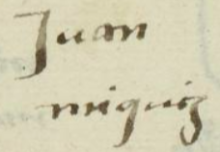Miquiz (MH624r)
This black-line drawing of the simplex glyph for the personal name Miquiz ("Death," attested here as a man's name), shows a shrouded corpse. The name Death is a day name in the 260-day divinatory calendar called the tonalpohualli. Calendrics were an important part of Nahuas' religious views of the cosmos. This death sign differs from some others from the Matrícula de Huexotzinco that appear in this collection. See below.
Stephanie Wood
A day sign like Miquiz would normally have a companion number from 1 to 13 with it. Because of colonial edicts to stop using the tonalpohualli as a source for names, one thing that happened is that the companion numbers were dropped, perhaps as a stopgap measure to reduce the sacred nature of the name. See Norma Angélica Castilla Palma, "Las huellas del oficio y lo sagrado en los nombres nahuas de familias y barrios de Cholula," Dimensión Antropológica v. 65 (sept.-dic. 2015), 186.
Stephanie Wood
Juan
miquiz
Juan Miquiz
Stephanie Wood
1560
Jeff Haskett-Wood
muerte, envolturas, sudarios, días, days, calendars, calendarios, dates fechas, nombres de hombres

miquiz(tli), death, https://nahuatl.wired-humanities.org/content/miquiztli
La Muerte
Stephanie Wood
Matrícula de Huexotzinco, folio 624r, World Digital Library, https://www.loc.gov/resource/gdcwdl.wdl_15282/?sp=330&st=image.
This manuscript is hosted by the Library of Congress and the World Digital Library; used here with the Creative Commons, “Attribution-NonCommercial-ShareAlike 3.0 License” (CC-BY-NC-SAq 3.0).









